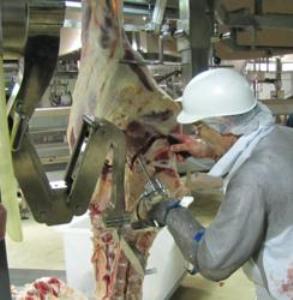The Meat and Livestock Australia (MLA) has chosen Kinea Design and Scoot Technology for developing and marketing HookAssist, the first collaborative robot for beef boning. HookAssist is a robot which has been designed to relieve workers at meat processing plants from the heavy physical demands while de-boning meat.
 A two-axis power-assist on the hook does 90% of the work of pulling, tearing, and/or lifting large sections of cut meat, while allowing four additional axes of passive motion for maneuverability.
A two-axis power-assist on the hook does 90% of the work of pulling, tearing, and/or lifting large sections of cut meat, while allowing four additional axes of passive motion for maneuverability.
The robot has more than 10 times the pull strength of the operator while de-boning meat. The robot works along with the workers by enhancing their physical strength, rather than replacing them. Kinea Design is working on the design and development of the robot while Scott Technology is working on the testing and marketing aspects of the robot. Currently the robot is being tested at a top meat processing unit and the product is scheduled to be released in the latter half of 2012.
MLA and Australian Meat Processor Corporation (AMPC) had initiated the development of HookAssist with the aim of using technology for increasing the yield and productivity and reducing accidents at meat processing plants. The manager of processing and efficiency sustainability at MLA, David Doral, pointed out that fatigue of the workers caused by extreme physical exertion causes a dip in the productivity and increases the chances of injuries. He added that by relieving the operator of physical exertion, they are able to concentrate on their work and hence the yield goes up. The power-assist on the robot, having two axes, provides 90% of the force required while pulling, lifting or tearing sections of meat. The additional axes are used to improve manoeuvring. The workers can control the force from the robot with the help of the handle on the gimbal; there is no concept of button involved. Kinea Design was chosen for designing the HookAssist based on global review which revealed that their engineers had helped in tackling similar challenge in the automotive industry. Scott Technology has invested in HookAssist and is working with MLA to market it at a global level. HookAssist was initially designed for de-boning the hind quarter of beef, it can however be extended for many applications such as small stock boning and slaughter, forequarter boning and other strenuous meat processing applications.